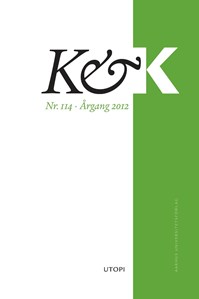Tilbage til kosmos. Den sovjetiske rumfartsmytologi i litteratur, film og kunst efter kommunismens fald
DOI:
https://doi.org/10.7146/kok.v40i114.15705Nøgleord:
Soviet Union, space travel, utopia, ideology, nostalgia, art, film, literatureResumé
BACK TO KOSMOS | In the decades following World War II, the utopia of a future communist state in the Soviet Union became linked to the tech nological conquest of cosmos through space travel. This relation found a primary expression in the heroic myths created in the popular visual culture surrounding the Soviet space program. After the collapse of the Soviet regime, the aesthetics and politics of its space ideology have been subjected to critical evaluation as part of a wider struggle over the legacy of the communist era. This article discusses three recent art works dealing with this issue: Victor Pelevin’s novel Omon Ra (1992), Adam Bartos’ photo book Kosmos – A Portrait of the Russian Space Age (2001) and Aleksei Fedorchenko’s film First on the Moon (2005). The article argues that the three works illustrate a development in the relation to the space myth from critical denunciation and even ridicule to ambivalent nostalgia. It is further suggested that this development is symptomatic for a wider change in the attitude towards utopic projects, which is not only expressed in the changing assessment of the legacy of the SovietUnion in Russia, but also in the aesthetic and political imaginary in our post-political era.
Downloads
Publiceret
2012-12-20
Citation/Eksport
Ladegaard, J. (2012). Tilbage til kosmos. Den sovjetiske rumfartsmytologi i litteratur, film og kunst efter kommunismens fald. K&K - Kultur Og Klasse, 40(114), 93–108. https://doi.org/10.7146/kok.v40i114.15705
Nummer
Sektion
Artikler
Licens
Tidsskriftet følger dansk ophavsret.





